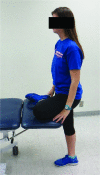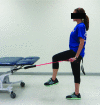THE EFFECT of ONE-ON-ONE INTERVENTION in ATHLETES with MULTIPLE RISK FACTORS for INJURY
- PMID: 31681498
- PMCID: PMC6816296
- DOI: 10.26603/ijspt20190384
THE EFFECT of ONE-ON-ONE INTERVENTION in ATHLETES with MULTIPLE RISK FACTORS for INJURY
Abstract
Background: Lower extremity injuries in soccer players are extremely common. Implementation of group injury prevention programs has gained popularity due to time and cost-effectiveness. Unfortunately, players with greater number of risk factors are most likely to sustain an injury, yet less likely to benefit from a group injury prevention program. The purpose of this study was to determine if targeting these high risk players with one-on-one treatment would result in a reduction in the number of risk factors they possess. The authors hypothesized that fifty percent or more of subjects receiving one-on-one intervention would have a reduction of ≥1 risk factor(s).
Study design: Quasi-experimental pretest-posttest design.
Methods: Division I men's and women's soccer players were screened for modifiable risk factors using a battery of tests which assessed mobility, fundamental movement pattern performance, motor control, and pain. Players with ≥ 3 risk factors ("high risk") received one-on-one treatment from a physical therapist via an algorithm twice per week for four weeks. Players with < 3 risk factors ("low risk") did not receive one-on-one intervention.
Results: The proportion of treatment successes in the intervention group was 0.923 (95% CI 0.640-0.998). A significant proportion of high risk subjects (0.846) became low risk at posttest (p = 0.003). A significant between group difference was noted in risk factor change from pretest to posttest (p = 0.002), with the median risk factor change in the intervention group being -3.
Conclusion: Utilizing one-on-one interventions designed to target evidence-based risk factors is an effective strategy to eliminate LE musculoskeletal injury risk factors in high risk individuals.
Levels of evidence: 2b.
Keywords: injury prevention; injury risk; movement system; soccer.
© 2019 by the Sports Physical Therapy Section.
Figures




















































References
-
- Chandran A Barron MJ Westerman BJ, et al. Time Trends in Incidence and Severity of Injury Among Collegiate Soccer Players in the United States: NCAA Injury Surveillance System, 1990-1996 and 2004-2009. Am J Sports Med. 2016;44(12):3237-42. - PubMed
-
- Effgen SK. Meeting the physical therapy needs of children. 2nd ed. Philadelphia: F.A. Davis Co. 2013.
-
- Hewett TE Myer GD Ford KR, et al. Biomechanical measures of neuromuscular control and valgus loading of the knee predict anterior cruciate ligament injury risk in female athletes: a prospective study. Am J Sports Med. 2005;33(4):492-501. - PubMed
-
- Verrall GM Slavotinek JP Barnes PG, et al. Hip joint range of motion restriction precedes athletic chronic groin injury. J Sci Med Sport. 2007;10(6):463-6. - PubMed
LinkOut - more resources
Full Text Sources
Research Materials
Miscellaneous
